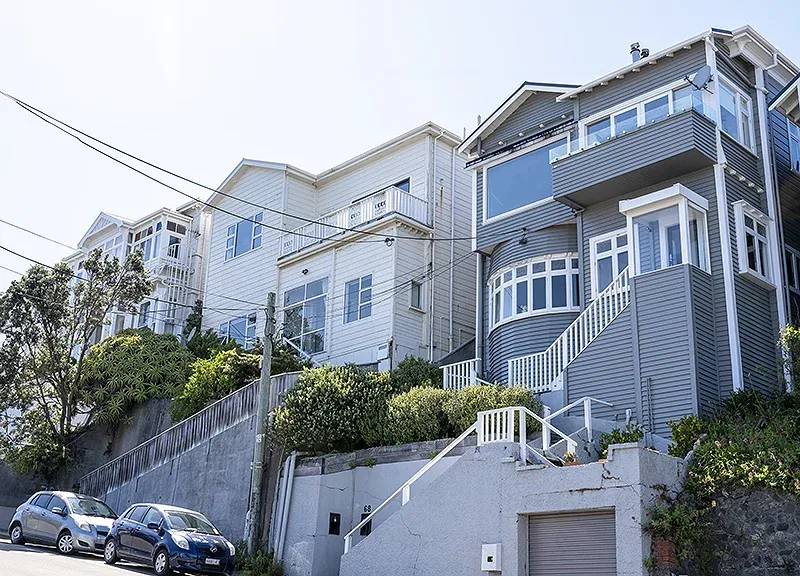What to know about retaining walls
By MAS Team
Do you have retaining walls on your property? Find out their structural risks and what that might mean for your insurance cover.
We all know that Aotearoa New Zealand is an incredible place to live, but it’s not nicknamed the Shaky Isles for nothing. Recent years have also reminded us that earthquakes are not the only natural hazard we face. Major storms that cause flooding and landslides are also becoming more frequent across the motu.
All of these hazards pose significant threats to our properties and the land we live on. To help minimise potential damage to our patch, or at least be best prepared, it’s important that we know what kind of issues we need to look out for.
One particular feature of residential land that we often don’t pay much attention to is the retaining wall. These unassuming structures are common across New Zealand and are very important in their function, but not without their risks. Recent changes to the Natural Hazards Insurance Act also mean that if your retaining wall were to fail, you may not be covered to the extent you’d actually need to repair or replace it and deal with the damage. So, we asked the experts to shed some light on this key topic that affects many Kiwis.

MAS Member Kate Williams, QSM, is a Principal Consultant Geologist at Tonkin + Taylor and explains in simple terms, “A retaining wall is a structure built to retain land and hold it back from sliding or falling.” They are most common in hilly areas or on sloped terrain to create level areas, stabilise soil and protect slopes subject to landslides or erosion. Retaining walls are typically made from timber or concrete, but there’s a lot more than meets the eye too.
“It’s not just what you see on the surface,” explains Kate. “There’s a whole support system that goes around it. Some of the retaining wall is embedded into the ground to certain depths, there may be anchors and cabling going into the ground at different angles, there can be large concrete beams that are joining a whole lot of embedded piles together, and, most importantly, a drainage system behind the wall, too.”
Of course, that’s if they’re well designed, engineered and up to the current code. Unfortunately, many are not.
Mark Fisher, General Insurance Claims Technical Manager at MAS, says, “In a typical Wellington property going up the hillside, the retaining walls might be 50 or 60 years old, and they will likely have no engineering in them at all. Often people don’t even realise that what they’ve got is a retaining wall.”
Kate adds, “Before the 1990s, some retaining walls were probably built by a local handyman. They may have been constructed appropriately for the time, however, over the years that wall will have been subjected to many weather events, heavy vegetation growth, poor drainage and possible deterioration, or even further development on the site not taking into account the wall and its support system.”
So a first and important step in being prepared is making sure, as much as possible, that any retaining walls on your property are fit for purpose. “If they’re old, they’ve got cracks in them or they’ve deteriorated, they’re not going to perform as they were intended to on the day they were constructed,” says Kate. Maintaining them and getting them checked by an engineer with the right expertise is always a good step.
Sadly, however, it’s still not quite a case of problem solved. As Mark explains, even when your retaining wall is modern and up to code, there is still always a risk. “There was a scenario in Auckland where the property had a new retaining wall that was well engineered, no issues with it at all, and during the Auckland weather event, the whole hillside gave way. The retaining wall came into the living room. So, even though you might think it’s all good, there’s still a massive risk that people need to be aware of.”
If, despite best endeavours, your retaining wall fails suddenly in a seismic or weather event, where does that leave you? Well, things have changed on that front, too. When the Earthquake Commission (EQC) officially became the Natural Hazards Commission (NHC) Toka Tū Ake last year, new legislation around residential natural hazards cover came into place.
Derek Smith, Senior Natural Hazard Claim Specialist at MAS, explains, “The amount of cover you’ll receive has now been capped at $50,000, and that’s for all retaining walls on your property, not per wall.”
What the NHC will provide is described as a “contribution”, and in most cases that contribution will only go so far. The standard MAS cover extends to $100,000, but this can be increased if required, and it may well be by the Member.

Mark says, “People might just think, ‘Oh, there’s that little wall in my garden, if that falls down it might cost me $20k to $30k.’ But in the case of that property in Auckland, it was hundreds of thousands of dollars. Of course, your insurance cover will top up that contribution to whatever your policy limit is, but we don’t cover land. No insurance does.”
In terms of how the NHC’s contribution is calculated, it’s based on the value of the land, says Mark. “That means if you’re in one of the big cities, you might get a reasonable amount, but if you’re in a smaller town, it’ll be much less.”
Kate adds, “The reality is that there’s not always enough money in a settlement for the reinstatement or repair of a retaining wall, because you’re not just fixing the failed wall, you’re having to put in a retaining system that meets today’s standards.”
And then there’s the associated costs. “Sometimes you have to remove more in order to rebuild because it’s all damaged or in the way of the new construction,” Kate continues. “Those costs will vary depending on how big the wall is, the investigation and design elements involved, consenting requirements, survey requirements, and so on. These processes can take months to years, and in that time, homeowners might be out of their homes.”
Another factor to be aware of: It’s not just natural hazards that cause disruption. Sometimes retaining walls can just gradually fail over time. “They can lose their functionality or capacity to retain if they rotate significantly. This gradual failure can come from other factors, including the deterioration of construction materials, increased loadings from structures above the wall, or ground water building up behind them,” says Kate. “These gradual failures are not considered natural hazard damage and there would be no contribution from the NHC.” It’s also worth noting that a MAS House Insurance Policy won’t cover gradual damage.
So, that’s the bad news. And while the hope is that MAS Members will never face these challenges, the team believes that forewarned is forearmed. Knowing what’s at stake and what would be covered can help people be more prepared now, rather than finding out and facing big costs after the fact.
If you’re looking to purchase a property that has a retaining wall, the key is to go in with your eyes open. “You just need to do your due diligence and be aware,” says Kate. “It might be that you still choose the same property, but you put some money aside in case something does happen. Or you could put more effort into maintaining your retaining wall, removing any vegetation surrounding it, checking drainage and getting an appropriate professional to take a look if cracks or deterioration do appear. Being a bit more proactive would definitely stop some of the failures that we’re seeing in the residential space.”
Mark also recommends getting the right advice from the outset. “People often rely on a pre-purchase report to pick up any potential issues with a property. The problem is they’re usually done by a builder who doesn’t have geotechnical experience to advise on retaining walls. So, it’s that next step of saying, ‘If I want to buy this lovely house that’s on a terrace, who should I ask for advice?’”
While the issues around retaining walls can be off-putting, Kate points out that all properties have risks in New Zealand and, in the end, the best option is to be where you’re happy but be prepared. She points to a quote from former Prime Minister Sir Geoffrey Palmer that captures it well: “Sometimes it does us a power of good to remind ourselves that we live on two volcanic rocks where two tectonic plates meet, in a somewhat lonely stretch of windswept ocean just above the Roaring Forties. If you want drama – you’ve come to the right place.”
“If you’ve got a large tree close to your property, then as soon as it’s windy or there’s heavy rain, the leaves are likely to fall onto your roof and block your gutters. That water has to go somewhere, and 9 times out of 10 it will go into your house,” says Mark. “That’s probably the biggest cause of claims every time there’s a storm.”
“The other issue with trees is root systems,” adds Kate. “If you look at the full extent of the canopy of a tree, that is essentially the full extent of its root network. Sometimes the root network goes beneath a house, and Auckland soils in particular can be subject to shrink/swell conditions because of the clay make-up of those soils. So in summer, the trees suck all the moisture out of the ground and you end up with all these ground cracks, then parts of the house foundations may crack as well. But that’s not a natural disaster, so it’s not covered by the NHC. We always recommend that there’s a clear area around the house. It’s also key when it comes to fires.”
This article provides general information only and is not intended to constitute legal or financial advice. Before taking out any insurance product, you should carefully consider the terms and specific policy wording. Underwriting criteria will apply.

When it comes to safeguarding our possessions and financial security, the importance of contents insurance shouldn’t be overstated.

The amount you pay for car insurance will come down to factors like how much your car is worth, what type of insurance you want, and your driving history.

On the hunt for your first home? Don’t just fall for street appeal, keep these 5 factors in mind when looking at houses to save you from unnecessary stress and hidden costs.